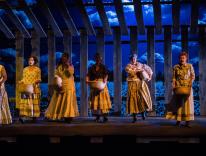A few drops of water sprinkled on a child’s feverish forehead and the words of baptism secretly muttered by a servant girl unsure of the rite. What incident could be more meager? Yet the words were muttered and the forehead moistened in a Jewish household in Bologna, still a papal state in the 1850s. And so six-year-old Edgardo, who had easily recovered from his illness, was taken from his parents, Momolo and Marianna Mortara, when their maid finally reported her deed. The Catholic Church had long discouraged such covert christenings, but what was done was done, and a baptized child could not be allowed to live with his Jewish parents. While Momolo first petitioned, then campaigned to retrieve his son, Edgardo dwelt in Rome, becoming the ward and pupil of the church and the apple of Pope Pius IX’s benevolently beaming eye. The Risorgimento was underway in Italy, and, for liberals and freethinkers, the boy’s plight was one perfect reason (among many) to separate church and state, while for the ecclesiastical hierarchy, the transcontinental fuss that ensued was one perfect symptom (among many) of atheistic nationalism and materialistic rationalism.
Virtually everyone stomped into the fray: Garibaldi (who actually wrote a novel about the case), the Jesuits, Napoleon III, the Rothschilds, the New York Times, the Jewish communities of two continents, Count Cavour, King Victor Emmanuel II. You can read all about it in David Kertzer’s 1997 book, The Kidnapping of Edgardo Mortara (Knopf), on which Alfred Uhry (the author of Driving Miss Daisy) has based his new play, Edgardo Mine, directed by Doug Hughes and presented by Hartford Stage from October 17 through November 17, and perhaps to be seen in other theaters in the future.
Instead of the epic the material seems to demand, Uhry has crafted something surprisingly circumscribed. Five important characters (child, parents, Pius IX, and his secretary of state, Cardinal Antonelli), supported by fifteen bit players. Only two major settings: the pope’s reception room and the Mortara household. A series of brief episodes, each involving no more than three or four players. A ninety-minute running time accomplished in one act. In short, a chamber piece.
How were this brevity and compactness achieved? By virtually eliminating the internationality of an international incident. Gone are Napoleon III and his French troops (who alternately maintained and threatened papal power); gone the Duke de Gramont’s plot to snatch Edgardo from the Vatican; likewise all the other interventions of diplomats and theologians. In fact, Uhry has rendered the politics of the case quite sketchily, except for the play’s conclusion which makes it clear that Pius IX, having maintained the Italian Jews in various ghettos, is now himself confined, by national unification, to a ghetto of his own called Vatican City.
And what do this brevity and compactness achieve? A family conflict. For if the parents naturally want Edgardo back, the pope desires to keep him not just to vindicate papal power but because he regards the boy as a soul saved and himself as Edgardo’s spiritual father. Clearly, Uhry wanted to keep his antagonists almost equally sympathetic (with an understandable tilt toward the bereft parents), and equally convinced of the justness of their causes. It’s also clear that Uhry realized that, writing for an American audience in which even the Catholic members (perhaps especially the Catholic members) regard the separation of church and state as one of the bases of liberty, he would have to work extra hard to make the pope’s position viable or even bearable.
Was it for this reason that Pius gets the first entrance, solus, and immediately makes the audience his confidant, soliciting its sympathy in a joking, winking, cajoling manner? To be sure, Shakespeare introduces his arch-villain Richard III in the same way. As all playwrights know, there’s a giggly satisfaction in being on equal terms with a monster. And indeed, this Pius IX, with his smarmy friendliness ("Call me Nono"), his condescending knowingness, and his hammy tendency to interrupt the action with explanatory asides, does at first seem like one of those villains you love to hate. Yet, as the play wears on and as the pope constantly demonstrates his affection for the boy and his certainty that he is saving a soul, the smarminess wears off and we are strongly tempted to like the man. Eliminated are the irascibility of the historical Pius IX and his deep suspicion of all Jewry; emphasized are the personal charm and the paternal care. We may regard this stage Nono as wrong but charmingly wrong, as overweening but glamorously overweening. In theater, charm trumps ethics any day, so Uhry has employed charm as a strategy for making American audiences countenance Pius’s ethics. A shrewd tactic. Conversely, so much visceral sympathy must we have for the bereft parents that Uhry perhaps felt he could afford to give them a certain fallibility. In theory that, too, is a shrewd move but, as executed by Uhry, it hasn’t paid off.
Momolo Mortara, in reality a tower of strength who worked courageously and unstintingly to regain his son, appears in this play as a ditherer, incapable of anything but a couple of laughingly ineffective schemes and cringing flattery of the authorities. At the play’s climax he is willing to accept the only solution offered by the pope: baptism for himself and his entire family. At a postperformance discussion, I asked Michael Wilson, the artistic director of Hartford Stage, about Momolo’s deflation and Wilson replied that Uhry wanted to focus strictly on two antagonists, mother vs. pope, la mamma vs. il Papa. So, in the play it is Marianna who spearheads the secular press’s advocacy of the family (in reality she spent much time in bed, psychologically prostrated), defies the pope to his face (she never met him), and vetoes her husband’s decision to have the family convert (no one in the family ever considered conversion a serious option). Uhry also makes Marianna the co-narrator of the play in opposition to the pope.
Well, Schiller and Shakespeare made mincemeat of history, too, but produced masterpieces. Why should Uhry be condemned for fictionalizing?
I believe fictionalizing is commendable when it helps the playwright drive home basic truths about his subject. I have no objection to Uhry’s inventing a face-to-face meeting between the parents and the pope. But it is truth, even a general air of reality, that I find lacking when Marianna snarls at Pius IX like an indignant councilwoman taking a small town’s mayor to task. Pius was the latest avatar of an ecclesiastical monarchy that had held the Jews in abject helplessness for more than a millennium, yet Marianna shows no sign of trepidation, much less fear, much less concern that she may be losing her chance to get back her child. Uhry’s attempt to empower his heroine ends up making her look like a headstrong fool. In contrast, the pope’s mild reaction seems to be the response of a reasonable man. Is this what the playwright intended? I doubt it.
Both the dialogue and the acting reinforce this accidental favoring of the pope. In the scenes between Pius and his secretary of state, the writing is adroit enough to suggest a good translation of a good Italian play, but whenever the Mortaras enter, Uhry recycles the colloquialisms of Molly Goldberg ("Again with the runaround?"). As Marianna, Randy Graff was all brass and bray, doing nothing to suggest the woman’s agony. But the redoubtable Brian Murray (the original Rosencrantz in Rosencrantz and Guildenstern Are Dead) caught the oleaginous charm of Uhry’s Pius IX to perfection.
It must also be said that one of Uhry’s devices worked well enough to capture the Rashomon aspect of the Mortara affair. In the actual case, the family stated that the child welcomed his parents’ visits to Rome and wanted to return to his former life, while the Catholic press reported that Edgardo declared his love for Nono and urged his parents to convert. Uhry presents both versions by presenting the visit twice, once for each version of reality, thus underlining the central mystery of the Mortara affair: What was going on in the mind of Edgardo?
Though he not only converted to Catholicism but became a priest, we may wonder if a gentle form of brainwashing wasn’t achieved. What chance did a six-year-old boy’s mentality have against the splendidly robed and solicitous missionary launched at him amid the splendors of the Vatican? In later years did Edgardo, fervent priest though he remained all his long life, never have any second thoughts about a destiny induced by a childhood illness, a confused servant girl, and a few drops of water? Edgardo’s conversion and its tenacity would probably be best served by a novelist rather than a playwright, and yet the theater, for all its hunger for color and bustle, can convey purely mental conflict, too, as certain plays from Hamlet to Endgame have shown.
The play over, the lights came up and I gazed at the vacant set. It comprised two segments: a stage floor level with the audience, that had been used for all colloquies and arguments between the main characters; behind and above the stage floor was a bleacher-like structure on which proclamations had been announced, newspaper headlines shouted, and over which soldiers scrambled. The stage floor had been the place where history had been made in private, while the bleachers had been reserved for public clamor. What struck me was how little the bleachers had been used, and how they could have been dispensed with altogether. Perhaps the most poignant drama that the Mortara case can yield took place inside a child’s head.
Please email comments to [email protected] and join the conversation on our Facebook page.
Share
Previous Story
Faith & Government
Next Story
After Law

